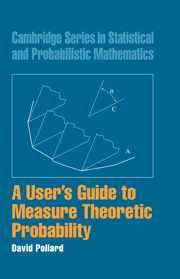Book contents
- Frontmatter
- Contents
- PREFACE
- CHAPTER 1 MOTIVATION
- CHAPTER 2 A MODICUM OF MEASURE THEORY
- CHAPTER 3 DENSITIES AND DERIVATIVES
- CHAPTER 4 PRODUCT SPACES AND INDEPENDENCE
- CHAPTER 5 CONDITIONING
- CHAPTER 6 MARTINGALE ET AL.
- CHAPTER 7 CONVERGENCE IN DISTRIBUTION
- CHAPTER 8 FOURIER TRANSFORMS
- CHAPTER 9 BROWNIAN MOTION
- CHAPTER 10 REPRESENTATIONS AND COUPLINGS
- CHAPTER 11 EXPONENTIAL TAILS AND THE LAW OF THE ITERATED LOGARITHM
- CHAPTER 12 MULTIVARIATE NORMAL DISTRIBUTIONS
- APPENDIX A MEASURES AND INTEGRALS
- APPENDIX B HILBERT SPACES
- APPENDIX C CONVEXITY
- APPENDIX D BINOMIAL AND NORMAL DISTRIBUTIONS
- APPENDIX E MARTINGALES IN CONTINUOUS TIME
- APPENDIX F DISINTEGRATION OF MEASURES
- INDEX
CHAPTER 5 - CONDITIONING
Published online by Cambridge University Press: 29 March 2011
- Frontmatter
- Contents
- PREFACE
- CHAPTER 1 MOTIVATION
- CHAPTER 2 A MODICUM OF MEASURE THEORY
- CHAPTER 3 DENSITIES AND DERIVATIVES
- CHAPTER 4 PRODUCT SPACES AND INDEPENDENCE
- CHAPTER 5 CONDITIONING
- CHAPTER 6 MARTINGALE ET AL.
- CHAPTER 7 CONVERGENCE IN DISTRIBUTION
- CHAPTER 8 FOURIER TRANSFORMS
- CHAPTER 9 BROWNIAN MOTION
- CHAPTER 10 REPRESENTATIONS AND COUPLINGS
- CHAPTER 11 EXPONENTIAL TAILS AND THE LAW OF THE ITERATED LOGARITHM
- CHAPTER 12 MULTIVARIATE NORMAL DISTRIBUTIONS
- APPENDIX A MEASURES AND INTEGRALS
- APPENDIX B HILBERT SPACES
- APPENDIX C CONVEXITY
- APPENDIX D BINOMIAL AND NORMAL DISTRIBUTIONS
- APPENDIX E MARTINGALES IN CONTINUOUS TIME
- APPENDIX F DISINTEGRATION OF MEASURES
- INDEX
Summary
SECTION 1 considers the elementary case of conditioning on a map that takes only finitely many different values, as motivation for the general definition.
SECTION 2 defines conditional probability distributions for conditioning on the value of a general measurable map.
SECTION 3 discusses existence of conditional distributions by means of a slightly more general concept, disintegration, which is essential for the understanding of general conditional densities.
SECTION 4 defines conditional densities. It develops the general analog of the elementary formula for a conditional density: (joint density)/(marginal density).
SECTION *5 illustrates how conditional distributions can be identified by symmetry considerations. The classical Borel paradox is presented as a warning against the misuse of symmetry.
SECTION 6 discusses the abstract Kolmogorov conditional expectation, explaining why it is natural to take the conditioning information to be a sub-sigma-field.
SECTION *7 discusses the statistical concept of sufficiency.
Conditional distributions: the elementary case
In introductory probability courses, conditional probabilities of events are defined as ratios, ℙ(A∣B) = ℙAB/ℙB, provided ℙB ≠ 0. The division by ℙB ensures that ℙ(· ∣ B) is also a probability measure, which puts zero mass outside the set B, that is, ℙ(Bc ∣ B) = 0. The conditional expectation of a random variable X is defined as its expectation with respect to ℙ(· ∣ B), or, more succinctly, ℙ(X ∣ B) = ℙ(XB)/ℙB. If ℙB = 0, the conditional probabilities and conditional expectations are either left undefined or are extracted by some heuristic limiting argument.
- Type
- Chapter
- Information
- A User's Guide to Measure Theoretic Probability , pp. 111 - 137Publisher: Cambridge University PressPrint publication year: 2001



